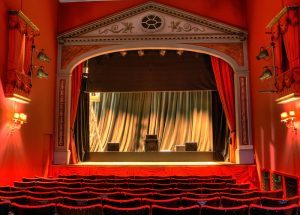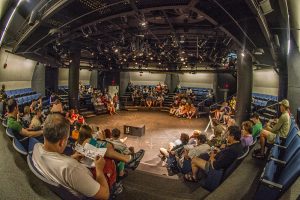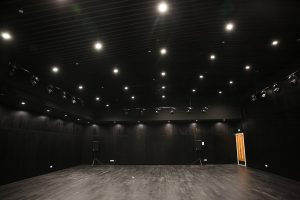7 Chapter 7: An Introduction to the Theater and Its Elements

Introduction
“All the world’s a stage” by William Shakespeare
(from As You Like It, spoken by Jaques)
All the world’s a stage,
And all the men and women merely players;
They have their exits and their entrances;
And one man in his time plays many parts,
His acts being seven ages. At first the infant,
Mewling and puking in the nurse’s arms;
And then the whining school-boy, with his satchel
And shining morning face, creeping like snail
Unwillingly to school. And then the lover,
Sighing like furnace, with a woeful ballad
Made to his mistress’ eyebrow. Then a soldier,
Full of strange oaths, and bearded like the pard,
Jealous in honour, sudden and quick in quarrel,
Seeking the bubble reputation
Even in the cannon’s mouth. And then the justice,
In fair round belly with good capon lin’d,
With eyes severe and beard of formal cut,
Full of wise saws and modern instances;
And so he plays his part. The sixth age shifts
Into the lean and slipper’d pantaloon,
With spectacles on nose and pouch on side;
His youthful hose, well sav’d, a world too wide
For his shrunk shank; and his big manly voice,
Turning again toward childish treble, pipes
And whistles in his sound. Last scene of all,
That ends this strange eventful history,
Is second childishness and mere oblivion;
Sans teeth, sans eyes, sans taste, sans everything.
See how this passage is translated into performance by Sophie Stone for the Shakespearean Globe Theatre:
And now, watch actor Benedict Cumberbatch (et al.) perform Shakespeare’s “All the world’s a stage” for film in this BBC montage:
Do you perceive the words differently when they are performed versus when read on paper? Today, we often read dramas as fiction or poetry, but the original intent of a play (or screenplay) is for performance.
In watching a play, or virtually any other type of dramatic or theatrical event, we are taking part in an activity that has been occurring without much significant change for nearly 2,600 years. Sitting in a seat in a theater today, an audience member goes through the same experience that humans have been having for hundreds of generations. Walking into the theater, finding a seat, sitting down, waiting for the performance to begin, watching the actors, listening to the lines they speak, and reacting to them with laughter, emotions, and applause are all things that those great-great-great-great-great-ancestors of ours did too. The Western tradition of viewing plays goes back to the ancient Greek world. However, it also ties us into a very human urge—the desire to communicate. We are social creatures by nature. That is, we instinctively gather together and try to share our individual experiences with those around us—to fit in, to share information or ideas, to participate in the larger life and experience of the group, or just to be entertained as we live our lives in this world. The people of ancient Greece were just like us in that regard. They didn’t have all of the technology that we do today, but they did some very impressive things with what they had, and many of the techniques they developed for their theaters are still used today. The tools may have modernized, but the purpose is the same—to make the experience of live theater as engaging as possible for the audience.
The very natural human urge to perform is a part of our nature, as noted above. When we stop to examine just how much of our lives is affected by the urge to perform and that uses traditional theatrical elements, we will notice that this is all around us, ranging from the very simple use of our hands, faces, and bodies to add to or emphasize elements as we are telling a story to our friends or families all the way to the much more formal influences of performance, such as our celebrations, rituals, and other such events. Consider the performance-like nature of a church ceremony, or a wedding, or a court case. Except for the specifics of an individual event, the overall shape, form, and substance of many of these are the same throughout our culture—and even across some other cultures as well. We can even go as far as mentioning our games as young children through to adulthood. We very often learn through role-playing and make believe. We often find ourselves pretending to be something we aren’t to experience life through different eyes and perspectives.
Another part of the historical tradition of theater that has lasted from the ancient Greek world is the play itself. Again, the context of the plays, the cultures they reflect, and the specifics of the language, etc. have changed, but plays still address the people for whom they are written. They reflect those people’s ideas, goals, values, and cultures. If they didn’t, there wouldn’t be any communication. Imagine if you were to go see a play all about life in the Himalayan mountains, spoken in Tibetan and dealing with yaks and yetis. There might be very little that you would understand about that play. A similar phenomenon occurs when a new movie comes out that is not about something that you enjoy. You don’t see it because you don’t want to; you don’t expect to “get anything out of it.” We want to see stories that interest us, that are about people like us, that have a relevance to our own lives. That’s why the stories and plays that we watch today have changed in content but not in structure or techniques. Telling stories, whether in person, in writing, or as a performed play, is part of our human nature. It’s who we are.
Theater’s Unique Quality
Theater is often referred to as “the lively art.” Just what does that mean? Well, theater is a performance art, which means that it is performed live in front of an audience instead of being created and then viewed separately by an audience. Unlike the other performing arts (Music, Dance, and the Visual Arts), theater is unique. It stands apart from the others in a couple of specific ways.
These elements that make theater unique almost all concern the role of, and interaction with, the audience. The performers on stage have a real-time connection with the audience. They can hear them and their reactions to the performance. Sometimes, they can even see them. Occasionally, the play or the production will include direct audience interaction, which makes the connection between the performers and the audience an even more intimate experience. Generally speaking, since the performance takes place live, directly in the presence of the performers, an energy connection is developed. The performers “feel” the energy from the audience as they react to the play. In turn, the audience “feels” the human connection of the live performance, which then impacts the energy they share with the performer.
If you have never experienced this for yourself, consider this parallel. Even though we can hear our favorite musician’s music on the radio or via the internet, we still go to the musician’s concerts when feasible. Why? We want to experience personally the presence of the artist while sharing in the creation of the music in real time. It feels like it is more important because we are part of the live process of creating the work of art, the music. It is this same bond that audience members share with the performers on stage during a play.
Another way in which theater is special is in its collaborative aspects. The Greek philosopher Aristotle defined the 6 elements of drama as: Plot, Character, Thought, Diction, Song, and Spectacle, making clear the multi-faceted nature of theater. While we may look at these through a 21st-century lens, the elements remain integral to theatrical performance. Although at its most basic, theater requires one performer and one audience member, it is most typically a shared activity, involving both the seen and unseen collaborators, the actors and the technical departments; it takes a lot of people to put a play performance together. A general rule of thumb is that there are two to three people involved in a play for every performer who appears on the stage during a performance. All these people work together with the director and the performers to create the experience for the audience. Their purpose is to collaborate toward achieving the goals established by the director to bring the director’s interpretation of the message of the script to life, to be shared with the audience. If they do not collaborate effectively, the play won’t be successful. While theater shares the energy and audience proximity with other arts that are performed live in front of an audience, it stands apart because over the last 2,500+ years, plays have tried to show us “us.” That is, we see ourselves in a play. Our humanity is reflected back to us by the performers on the stage. The actors are humans, playing roles with human traits, with relevance to our culture, values, and sensibility. That’s something that the other arts cannot do with the same immediacy.
The Elements
Aristotle’s Poetics
Aristotle, largely considered the first literary critic, set out to define the elements of drama in Poetics (341 BCE). These elements are, in order of importance:
- Plot: the events or order of the events in the play, a.k.a. the story itself
- Character: the development of a character; a character must change and go through struggles to elicit “fear and pity” or catharsis
- Thought: the deeper themes, philosophies, or ideas reflected in the play
- Diction: the use of “poetic speech” or literary devices
- Song: the music that accompanies the drama
- Spectacle: the visual impact, such as props and costumes, or what we might today call special effects
While scholars today have a somewhat different idea about the important features of drama, they do mostly agree with Aristotle that the most important characteristic of drama is its plot.
Plot
Plot is the most important element in a narrative. It is the events in the play and the order in which the events are told. There is no one correct way to structure a drama! However, the structure of a drama is only as effective as it is intentionally formed to elicit the desired response from its audience. A play usually has a beginning, middle, and end. It almost always has a character grow and develop over the course of the play. Let’s look closely at one type of plot structure in order to see what plot might look like…
Setting
To provide the story’s setting, a play frequently incorporates sets. If you’ve ever been involved with a play, you know that the set can be made up of detailed backdrops, specifically designed props, strategic lighting, and sometimes even background noise. A set, along with the characters’ subtle indications of the scene, can generate a full setting in the audience’s imagination. For example, the play Hamlet starts its setting on a creepy, dark, foggy, cold night in the fictional Castle Elsinore in Denmark. The setting is often established on a stage, or the physical space upon which actors move. In order for a play to take place, there must be actors (people performing the play), an audience (people viewing the play), and action and/or dialogue as performed by the actors.
Character
While in short stories or novels a reader must wait until a character appears to know who the important characters are, in a play they are often the first aspect of the text encountered by readers. The character list usually appears in the first pages of the play. This is because, as a play emphasizes action over narration, the actors must know their parts!
Usually, the most important characters are listed first: think most spoken lines, protagonists, antagonists, etc. However, the order in which the characters appear on the character list does not necessarily dictate the order of appearance. Like in creative nonfiction or fiction, playwrights develop characters over the course of the play. Different characters serve different roles such as protagonist, antagonist, or foil. There are a few types of character archetypes unique to drama, which are described below. Note that not all of them will be in every play!
-
- Protagonist: Usually the character with the most spoken lines or the character around whom all the other characters seem to orbit. This is the main character, focused on trying to achieve a goal or overcome an obstacle (often, but not always, the hero/ine of the play). Hamlet would be an example of a protagonist. It should be noted that the protagonist is not always likable.
- Antagonist: This is the character that is preventing or standing in the way of the protagonist achieving their goal (often, but not always, the villain of the play, usually opposite the protagonist). Claudius would be an example of an antagonist. Note that this character is not always a villain and may even be a sympathetic figure.
- Foil: This is a character meant to define another character through juxtaposition or comparison. For example, in Hamlet, Old Hamlet and Old Fortinbras and Hamlet and Fortinbras are often considered foils of each other. Fortinbras and Hamlet are both on paths of vengeance, yet each goes about their vengeance in different ways. While Fortinbras uses military strength, Hamlet chooses to use his intellect. While Fortinbras is decisive, Hamlet seems paralyzed by indecision. By examining the ways in which these two characters are similar and different, we can learn a lot about each of them and their significance in the play.
- Wise elder: In many plays, there is a wise old man or figure of wisdom who guides the protagonist. In Hamlet, it might be the ghost of his father, or Polonius can be a silly inversion of this archetype.
- Love interest: Again, in most plays, there is usually a love interest of the protagonist, though not always. For Hamlet, this is Ophelia (though some scholars have argued Horatio!).
- Messenger: A character who delivers news.
Dialogue and Action
One of the main differences between fiction and drama is that usually a play’s plot is primarily forwarded through dialogue and action. Dialogue is comprised of the words directly spoken by characters, while actions are the physical movements of the actors. In a novel, action is described in detail, and dialogue is usually put in quotation marks. For instance, consider the following example of action and dialogue from The Picture of Dorian Gray by Oscar Wilde:
As the painter looked at the gracious and comely form he had so skillfully mirrored in his art, a smile of pleasure passed across his face, and seemed about to linger there. But he suddenly started up, and closing his eyes, placed his fingers upon the lids, as though he sought to imprison within his brain some curious dream from which he feared he might awake.
“It is your best work, Basil, the best thing you have ever done,” said Lord Henry languidly. “You must certainly send it next year to the Grosvenor. The Academy is too large and too vulgar. Whenever I have gone there, there have been either so many people that I have not been able to see the pictures, which was dreadful, or so many pictures that I have not been able to see the people, which was worse. The Grosvenor is really the only place.”
“I don’t think I shall send it anywhere,” he answered, tossing his head back in that odd way that used to make his friends laugh at him at Oxford. “No, I won’t send it anywhere.”
Distinct from the novel form of dialogue evidenced above, in a play, any words that come after the character’s name will be considered dialogue. Action is usually not described in great depth, and actors are to interpret what actions to take based on the dialogue. Consider this example from Hamlet by William Shakespeare:
MARCELLUS: Holla, Bernardo!
BERNARDO: Say,
What, is Horatio there?
HORATIO: A piece of him.
BERNARDO: Welcome, Horatio. Welcome, good Marcellus.
MARCELLUS: What, has this thing appear’d again tonight?
BERNARDO: I have seen nothing.
In the above excerpt from the beginning of the play, Marcellus, Bernardo, and Horatio (soldiers) greet each other as they patrol the castle. When Horatio says “a piece of him,” we might imagine the fog is so thick or the night so dark that only pieces of each character can be seen. Horatio might be holding up his hand in the torchlight. We might imagine the characters wandering about in the dark speaking to each other, a bit rattled, worrying if the mysterious “thing” Marcellus references will reappear. We learn later in the dialogue that the “thing” is an apparition (ghost). None of the characters’ movements are described, so we must infer what their actions are through their dialogue.
Although a novel’s narrator can describe in detail the thoughts and impressions of its characters, a play’s effects depend much more heavily on what the characters say and do. A play is a performance, a spectacle, rather than words on paper. That is, drama is a story performed by actors. Some plays do include a narrator or a chorus, to introduce the scene or set the tone of the play, but the bulk of the production’s effect is generated through the dialogue and its visual devices, and since the play’s script dictates what the characters will say and often, through stage direction, its production strategies as well, the script is crucial to a successful performance.
The Theater Space
Theater can occur almost anywhere! There are a variety of building configurations, however, that are designed specifically for performance. Here are four very common stage types that you may encounter.
Proscenium Stage

This type of stage can be traditional or contemporary in appearance. It is characterized by a “proscenium arch,” which separates the audience space from that of the play. The effect is that of the audience members looking through a frame in on the action. The stage might be straight, in line with the arch, or project slightly outward in an area called the apron.
Take a 360-degree virtual tour of a theater featuring a proscenium stage: The Stifel Theater, St. Louis, U.S.A.
Thrust Stage

A thrust stage projects into the audience space and is surrounded on 3 sides by seating. This can create a more immediate, personal connection between the actors and audience because they are sharing the same space. This configuration can also make staging more challenging, as now, actors are projecting to multiple areas instead of one audience direction. (After all, who wants the actor with his back to you for an entire performance!)
Take a 360-degree virtual tour of a theater featuring a thrust stage: The Royal Shakespeare Theatre in Stratford-upon-Avon. (Note that this impermanent thrust stage has been put in front of a proscenium arch and the arch effectively blocked with a temporary “wall.”)
Arena Stage

An arena stage is an old idea (think of The Colosseum in Rome!) This type of stage is surrounded on all sides by the audience and carries with it many of the same challenges as that of a thrust stage in terms of staging and acting a scene. There are also additional technical considerations: What can audience members see? How will you change the set? Where can the lighting be angled to highlight the action without shining in the audience’s eyes? This stage configuration can be used in both large and small spaces.
Take a 360-degree virtual tour of a theater featuring a thrust stage: The Berlin Philharmonic, Berlin, Germany
Black Box Theater

A black-box theater is typically a small, plain, open room with capacity for about 100 people. As its name suggests, the space is usually black. It is well suited to experimental theater and provides an intimate theatrical experience; audience members might only be a few feet from the actors. Because the seating is not fixed, the space can be reconfigured as needed for a production.
Take a 360-degree virtual tour of a black-box theater: Margo Jones Theater, Dallas TX, U.S.A.
Check Your Understanding

